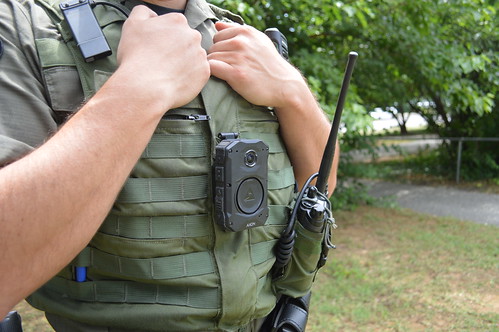
A Maryland Natural Resources Police officer wears an Axon body-worn camera, which have been distributed to all officers on the force. Photo by Hunter Dortenzo, Maryland Department of Natural Resources.
Following a 12-month pilot program, Maryland Natural Resources Police (NRP) has taken delivery of 275 Axon body-worn cameras, and has officially implemented an agency-wide program in which every sworn officer will wear cameras while on duty.
“The Maryland Natural Resources Police remains committed to maintaining the highest level of professional standards, integrity and conduct,” said NRP Superintendent Orlando D. Lilly. “Body-worn cameras improve the safety of not only the officer, but also the public. These cameras are an important tool to promote transparency and trust, and have the added benefit of increasing officer professionalism and training.”
Natural Resources Police officers were fully trained and outfitted with the cameras as of April 2024, more than one year ahead of the July 1, 2025 target deadline set in state law.
The Maryland Police and Correctional Training Commission has set guidelines for the development of agency body-worn camera program policy, which apply to all Maryland police agencies that use them. NRP has established standard operating procedures related to the use and management of our body worn cameras, outlined in agency Policy 421. NRP’s policy was derived after consultation and review with policies and procedures from outside and partner agencies which have effectively introduced body-worn camera programs.
NRP officers will wear Axon Body 4 cameras as part of a five-year agreement with the manufacturer.
These cameras bring an array of advanced features to Maryland’s public lands and waterways, including high-definition recording capabilities, improved low-light performance and an expanded field of view compared with most police body cameras in use today. Officers are required to upload their footage by the end of their shifts, which they can do when connected to their mobile workstation or via a docking system.
NRP policy allows for supervisors to review officers’ camera footage to conduct periodic reviews of interactions, review complaints that may arise, and use real-life video for training purposes. The cameras also enhance the accuracy of incident reports and court testimony, and help to improve community-police relations.
Studies have found up to 17 percent fewer use-of-force reports and complaints from citizens for officers wearing body-worn cameras compared to those without. Other studies report improvements in officer safety, increased evidence quality, and reduction of agency liability.
Body-worn cameras are currently activated during calls for service or law enforcement action, subject and traffic stops, and more as outlined by department policy. Axon cameras have the capability to automatically activate when vehicle emergency equipment (lights and sirens) are turned on, or when an officer’s firearm is unholstered.
The body cameras always operate on a “buffer”, which saves the previous 60 seconds of video prior to initial officer activation. Video is then secured digitally in a cloud-based evidence management system, and will be stored for a minimum of 42 months.
NRP’s body-worn camera program was made possible through grant funding from the Police Accountability, Community, and Transparency (PACT) Grant provided by the Governor’s Office Of Crime Prevention, Youth, And Victim Services. NRP’s contract with Axon includes 275 cameras and docking hardware, officer training, and unlimited cloud storage.


